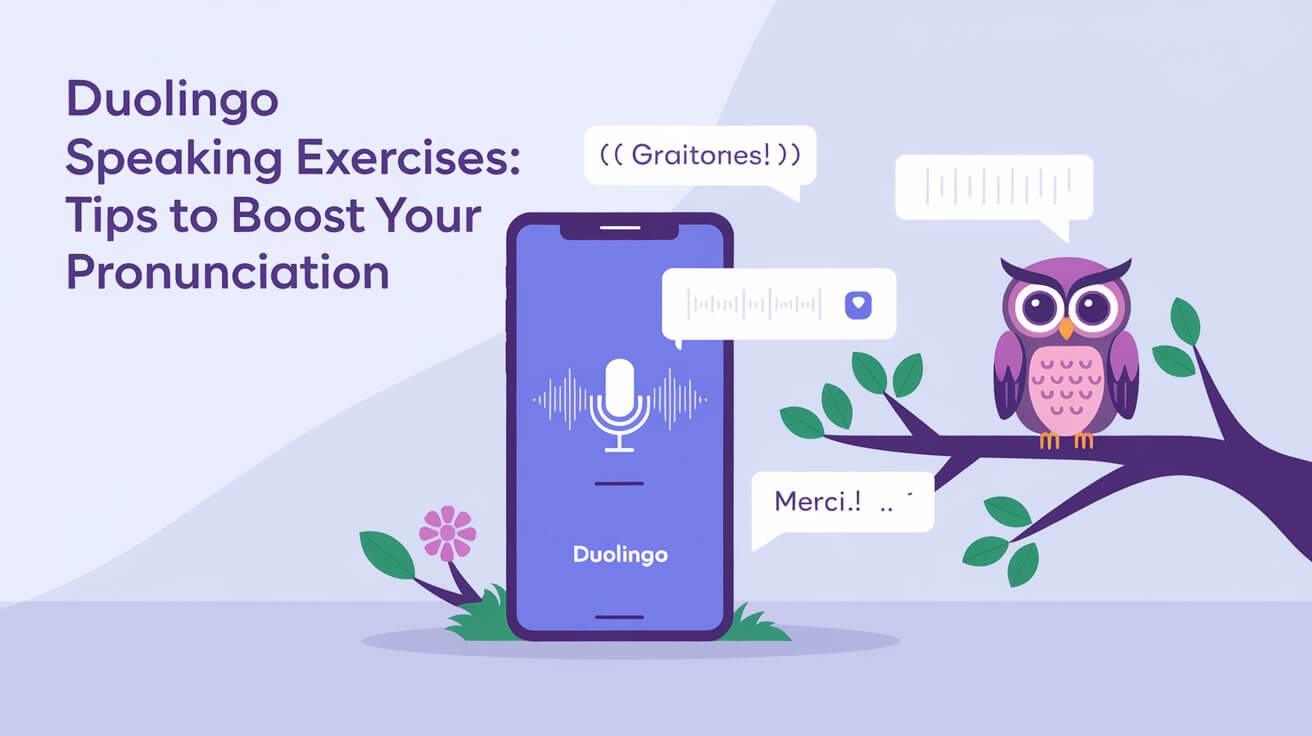Learning a new language needs a balanced approach. Duolingo’s lessons focus on speaking, writing, reading, and listening. It uses advanced AI to check your pronunciation in real-time.
Duolingo has activities for all levels, from beginners to advanced learners. You can practice conversations, daily routines, or even arguments. This helps you get better at speaking in your target language.
Core Elements of Speaking Practice on Duolingo
Duolingo offers a deep dive into learning languages. It focuses on three main areas: voice recognition, real-time feedback, and speech pattern analysis. These features help users improve their speaking skills in a fun and effective way.
Voice Recognition Technology
Duolingo uses top-notch speech recognition to check your pronunciation. It listens to how you speak and gives you feedback to get better. This helps you learn and grow your language skills.
Real-time Pronunciation Feedback
Duolingo is great at giving you real-time pronunciation feedback. When you say something right, it turns it blue. This shows you’re doing well and keeps you motivated to keep practicing.
Speech Pattern Analysis
Duolingo looks at more than just how you say words. It checks your rhythm, intonation, and fluency too. This gives you tips to improve your language proficiency and how you communicate.
These key parts of Duolingo’s speaking practice make learning a language fun and effective. It’s perfect for anyone, whether you’re just starting or already know a lot. Duolingo’s features help you get better at speech recognition and pronunciation exercises. This way, you can become a confident and skilled speaker.
Hidden Speaking Features in Translation Exercises
Duolingo, the famous language app, has a secret in its translation exercises. It lets users turn them into speaking practice. By tapping the microphone icon, users can speak their translations. This helps them practice speaking and pronunciation.
This feature gives users feedback on their pronunciation right away. It helps them improve their language skills. Users can also edit their answers before submitting. This lets them fine-tune their speaking skills.
Adding speaking to translation exercises makes learning more fun and effective. It helps users get better at both writing and speaking. As they use the duolingo speaking practice guide, this feature becomes very helpful.
Whether it’s through audio lessons or voice recording, Duolingo’s hidden features are great for practicing speaking. They make learning a language smooth and effective.
Speaking Practice Through Conversation Lessons
Duolingo’s conversation lessons are a fun way to get better at speaking. They use real-life scenarios to teach you how to talk in the target language. As you move on, the lessons get harder, helping you speak more smoothly.
Interactive Dialogue Scenarios
Duolingo’s lessons mimic everyday conversations. You’ll practice talking in different situations, like at a cafe or a hotel. It’s a fun way to improve your speaking skills.
Cultural Context Integration
Duolingo’s lessons also teach you about culture and how to communicate properly. You’ll learn about body language, tone, and etiquette. This is key for talking well in the target language.
Progressive Difficulty Levels
The lessons get harder as you go, keeping your speaking skills sharp. This way, you can get better at your own pace. You’ll learn the language’s complexities and grow more confident.
These lessons help you speak better and understand the culture behind the language. Duolingo’s fun approach makes learning a language easy and engaging. It’s great for conversation practice, improving spoken fluency, and gamified language learning.
Pronunciation Enhancement Techniques
Mastering pronunciation is key to improving your spoken fluency. Duolingo has many features to help you. Whether you’re new or getting better, improving pronunciation is a big step in learning a language.
Duolingo focuses a lot on listening skills. By listening to audio lessons and native speakers, you learn to recognize sounds and intonation. This helps you make these sounds yourself.
- Practice repeating words and phrases out loud. Focus on how you say them and the rhythm. This builds muscle memory for new words.
- Use online pronunciation guides and video tutorials for tricky sounds. These can give you tips and strategies to improve.
- Try the speak-out-loud method from Duolingo, even when alone. Saying the language out loud helps you get used to its rhythm and flow.
Improving your pronunciation takes time and practice. By using these techniques with Duolingo, you’ll get better at speaking. You’ll feel more confident in talking in the language.
| Pronunciation Challenges | Strategies for Improvement |
|---|---|
| Retraining mouth muscles for new sounds | Prioritize practicing sounds that aid in comprehension |
| Overcoming automaticity of native language pronunciation | Accept mistakes as part of the learning process |
| Challenges for intermediate and advanced learners | Focus on listening practice and exposure to natural language |
Daily Speaking Routines for Language Success
Creating a daily routine for speaking practice is crucial for improving your fluency in a new language. Whether you use Duolingo or other tools, setting aside time each day can greatly enhance your progress.
Morning Practice Sessions
Begin your day with a Duolingo speaking practice session. Spend 15-20 minutes talking about your morning, describing what’s around you, or sharing a memorable experience in your target language. This boosts your speaking skills and keeps you immersed in the language all day.
Repetition Strategies
- Repeat new words and phrases out loud several times to improve your pronunciation and memory.
- Record yourself speaking and listen to it, noting areas for improvement.
- Have short, repetitive conversations with a language partner or tutor to enhance your conversational skills.
Progress Tracking Methods
Use Duolingo’s progress tracking features to see how you’re improving. Set daily goals, track your streak, and review your analytics to stay motivated. Celebrate your achievements and adjust your practice routines as needed.
| Duolingo Speaking Practice Guide | Improving Spoken Fluency | Gamified Language Learning |
|---|---|---|
| 9 out of 10 times it is recommended to learn using the web version of Duolingo with a keyboard. | Setting a daily goal on “Insane” mode can be achieved by completing 3-4 runs. | Over 5,000 universities worldwide recognize the Duolingo English Test (DET) as a significant tool for English proficiency evaluation. |
| With the free app membership, users only receive 5 hearts daily to continue lessons, creating potential frustration and hindrances. | Recommendation to create verb, adjective, and pronoun cards for effective practice. | The speaking section of DET usually consists of around 4-5 speaking tasks. |
| Completing lessons up to level 5 is advised for maximum learning benefit. | Users advised to utilize Duolingo Stories to practice newly learned material effectively. | A score of 120 or above is generally considered a good score for DET and meets the requirements of many top universities. |
Audio Recognition and Response Training
Duolingo’s language learning platform uses speech recognition and audio lessons together. This mix helps users improve listening and speaking skills at the same time. By answering audio prompts, learners get better at speaking and listening with feedback right away.
The app lets users record their voice and compare it with native speakers. This helps them work on how they speak and sound. Duolingo’s way of teaching is all about mastering a new language through audio recognition and response training.
- Respond quickly to audio prompts to develop fluency
- Use the voice recording feature to analyze your pronunciation
- Compare your speech with native speaker samples for feedback
- Leverage speech recognition technology for accurate, real-time assessment
- Integrate audio lessons seamlessly with other language skills practice
Duolingo makes learning a new language fun and interactive. It helps users get better at speech recognition, audio lessons, and voice recording. These skills are key to speaking a new language well. Duolingo’s methods make learning a language an exciting and immersive journey.
| Feature | Description |
|---|---|
| Speech Recognition | Duolingo’s advanced speech recognition technology provides real-time feedback on pronunciation and intonation, helping users improve their speaking skills. |
| Audio Lessons | Interactive audio lessons integrate listening and speaking practice, allowing learners to respond to prompts and receive immediate guidance. |
| Voice Recording | The app’s voice recording feature enables users to compare their own speech with native speaker samples, identifying areas for improvement. |
Duolingo Speaking Practice Guide: Advanced Methods
As you get better at language learning with Duolingo, you can use the app’s advanced features. These can make your speaking practice even better. You’ll learn how to use your microphone right and try different speaking exercises.
Microphone Usage Tips
Make sure your microphone is set up right and in the best spot. It should be close to your mouth but not too close. This way, you get clear audio without any noise or distortion. Always check your microphone before you start speaking to make sure it works well.
Speaking Exercise Types
Duolingo has many speaking practice options, not just translating words. Try the interactive conversation lessons. They let you have real-life conversations. These lessons help you get better at speaking and learn about different cultures.
Performance Metrics
Keep an eye on the performance metrics Duolingo gives you. They show how you’re doing and what you need to work on. The app’s tools help you understand your pronunciation and fluency. Use these insights to improve your speaking and celebrate your progress.
Using the duolingo speaking practice guide can really help you get better at speaking. You’ll learn how to use speech recognition technology and try different speaking exercises. Plus, you can use the performance metrics to see how you’re doing and reach your language goals.
Combining Speaking with Other Language Skills
Learning a new language is more than just speaking well. It’s about mastering reading, writing, and listening too. Duolingo, a top language app, helps users improve all these skills. It offers features to boost your language skills overall.
Duolingo’s “Stories” feature is a great way to mix speaking with other skills. It lets users read aloud, which improves how they speak. This interactive reading helps learners practice speaking, listening, and reading together.
Another smart strategy is to do speaking exercises with translation. When users translate sentences, they work on grammar and vocabulary. This practice makes them better at speaking and writing naturally.







